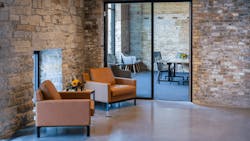ASID Report Examines the Rise of Adaptive Reuse
A recent Bloomberg headline declared, “One Nation, Under Renovation,” signaling a phenomenon: for the first time in 20 years, renovations have overtaken new construction in architectural billings in the built environment. Across the profession, designers are embracing “adaptive reuse”—the process of reusing an existing building for a purpose other than which it was originally built or designed for—to optimize the performance of built assets in a sustainable way.
With renovations on the rise, designers have had to adapt and innovate to meet the new demands of clients seeking effective strategies to recycle what already exists and convert their assets to meet their needs. Innovation is key, as scarcity of land, regulations and rising costs of materials and labor are hampering new construction. On the upside, this creates more opportunities for design firms that can compete for renovation projects.
In its 2023 Outlook Trends report, ASID found that overall, architectural renovations are outpacing new construction across the built environment, in the residential sector, as well as commercial, educational and senior living. Interior modernizations and upgrades and adaptive reuse endeavors comprise around half of all renovation projects.
The Trends report tracks societal and demographic trends impacting interior design and details the related implications for interior designers. In 2023, the report found that, across all sectors of the interior design industry, clients, companies and institutions are assessing how interior spaces can be reimagined to reduce negative environmental impacts, while improving health, safety and wellbeing. Lifestyles have changed for many reasons, and interior design is responding to the new ways we live, work, travel and unwind. Let’s take a look at how adaptive reuse projects have been shaping up across the following markets:
Commercial
In 2021, we saw the number of conversions of office buildings into apartments reach an all-time high—a trend that is only increasing. Overall, apartment conversions jumped 25% during 2020-2021. Conversions of office buildings jumped the most, by 43%, and made up the largest share of commercial conversion projects. With new multi-family construction slowing or stalled, conversions should provide alternative opportunities. ASID’s research also found that, in the workforce, redesigning for neurodiversity is increasingly popular, as employers are converting spaces to be more flexible and adaptable to support inclusive workforces.
Retired Living
Adapting commercial spaces could meet the demands of urban retirees looking for alternative senior living options. Perkins Eastman has produced a white paper exploring how adaptive reuse of commercial spaces could address the need for more and how alternative senior living spaces can meet the needs and preferences of aging baby boomers. Post-pandemic increased availability of office buildings, hotels, etc., changing preferences of older adults, and the “forgotten middle” financial challenges are just some of the factors impacting this market sector. For designers, conversions that combine living units with retail, restaurants, entertainment spaces and other uses could create new opportunities not only for designers who specialize in senior living, but also retail and hospitality.
Education
Schools are turning to renovation and adaptable reuse in place of new construction. Many schools are revamping or abandoning their current buildings as school districts consolidate and to make the facilities more secure and healthy. The high cost of new construction and the difficulty of finding and purchasing appropriate new sites make adaptable reuse an attractive alternative. School districts are engaging architectural and engineering firms to transform vacant retail, warehouse and other large-volume spaces into educational environments. Others are renovating existing buildings to modernize systems, modify wayfinding and upgrade interiors.
In addition to its research, ASID recognizes excellence in adaptive reuse projects through the National FOCUS Project Awards, which honor outstanding design that responds to challenges facing our world around climate, health and equity in the built environment. In 2023, the award was bestowed on HGA for the adaptive reuse of the Water Works Park Pavilion in downtown Minneapolis. Water Works was a public-private partnership between the Minneapolis Parks Foundation, the Minneapolis Park and Recreation Board, and The Sioux Chef to redevelop a three-acre industrial parcel overlooking the Mississippi River into a community destination that honors the history of the riverfront. Inspired by indigenous culture, the project preserved the heritage of the area while creating a welcoming space to serve the modern needs of the community.
